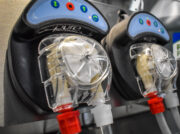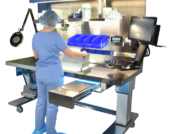
Planning for Patient Safety in the Sterile Processing Department
“Think of this tray as being YOUR patient.” The wise sterile processing director knows the importance of placing the patient front and center for SPD technicians. Technicians may not physically interact with the patient, but their work and diligence in sterile processing plays a direct role in patient safety.
Providing clean, working, sterile instrumentation for patient procedures is one of the most critical functions of the sterile processing department. It is evident that proper processing reduces or even eliminates hospital-acquired infections (HAIs) and contributes to safety and success of patient recovery.
A patient promise
Sterile processing leadership understands that patients should leave the hospital in better condition than when they arrived. They do their best to impart this message to their teams. It is a serious vow. A negative domino effect impacting patients and their recovery can occur without ideal processes and adherence to best practices in central sterile.
The negative domino effect is a perilous risk that is all too easy to trigger. The promise to send a patient home in better condition can be broken. Let’s look at ways patient safety efforts might be undermined, and review ways you can overcome them.
Where SPD patient safety efforts can break down
Here are three ways patient safety efforts might be interrupted:
SPD staffing skill issues
In today’s environment, maintaining skilled staff and hiring new staff has become a near impossible task thanks to so many alternatives to better pay and less hazardous conditions. Instrumentation issues (complexity of instruments and sets, loaners, IFU’s, less inventory) add to the difficulty for current staff.
Answers to these questions, followed by the right action plan, can help to address staffing skill issues:
- Are you preparing staff prior to new specialties or ramped up surgical procedures?
- Are new staff in place before those events occur?
- Do staff have access to continuing education?
Placing quantity over quality in sterile processing

This happens often when production demand shoots up, and especially with low numbers of skilled staff. It is too easy to fall into the trap of the “good enough” mentality. This happens when teams select quantity over quality on number of trays done per shift. In reality, the priority should be on number of trays processed properly (the quality) per shift.
Bottlenecks in productivity
Ever just throw more people at a problem? Most SPDs are forced to do so to overcome industry and hospital changes. Some of these bottlenecks can be minimized by listening to staff’s continuous improvement ideas, and standing in the middle of the problem, and just observing. Likely, the core of the issue is a 20-year-old design that hasn’t accounted for growth through additional space, effective workflows, and newer technology that enables staff productivity and safety. Identifying and planning that core change to remove bottlenecks is a good strategy for your staff and your department.
How can you deliver on the sterile processing patient promise?
How can you overcome the three issues above to deliver on the promise to send a patient home in better condition than when they arrived? Here are three ways to help you do so.
Make the investment in SPD equipment
It’s worth it to invest in technology that enables staff safety, and helps technicians be more productive. Throwing more people hours (without enough skilled people) at the problems can be counter-productive and lead to sickness, injuries, and possible staff turnover. Making technology investments in your current valued staff demonstrates your concern for their safety and wellbeing, enables their productivity, and lifts morale.
Quality enhancer
Having your OR 100% on board with point-of-use instrument care prior to coming to SPD will create incredible efficiencies for staff-starved SPD. If that’s not a reality in your facility, then focusing on pre-cleaning and cleaning processes of your instrumentation in decontamination will have greatest impact to patients. “If it’s not clean, it can’t get sterile” never changes. Cleaning with purpose and diligence will enable and enhance all quality assurances through processes to patient.
Space
Plan, justify, and fight for more space now, to correct what hasn’t happened, but to also account for what will happen in the next 5-10 years. As surgical procedures ramp, new specialties are added, instrumentation becomes more complex, and new staff is added, it will become more difficult to predict those future needs. You can never catch up to future production without the space, which allows added technology, and proper workflows for your team to perform. Without it, we go back to throwing people hours at the problem (see SPD staffing skill issues above).
Keeping the patient promise
Planning for patient safety and instilling a patient promise culture is valuable in every sterile processing department. Roadblocks will happen, staffing issues will occur. The best way to keep that patient promise is to shore up your department with well-trained staff, to anticipate future surgical load, provide the equipment necessary for ideal technician productivity, and avoid the temptation to “throw more people” at a problem.
Invest in your department with the right updates. Remember that quality should take precedence over quantity. Anticipate, plan, justify, and fight for the space requirements of your growing department before it becomes an emergency.
Patients rely on the promise of going home in better condition than when they arrived at the hospital. Let’s keep that promise for them.
Prepare for your departmental renovation or update with the best sterile processing partners in the business. Contact us today to speak with a specialist who can guide you through the process!



